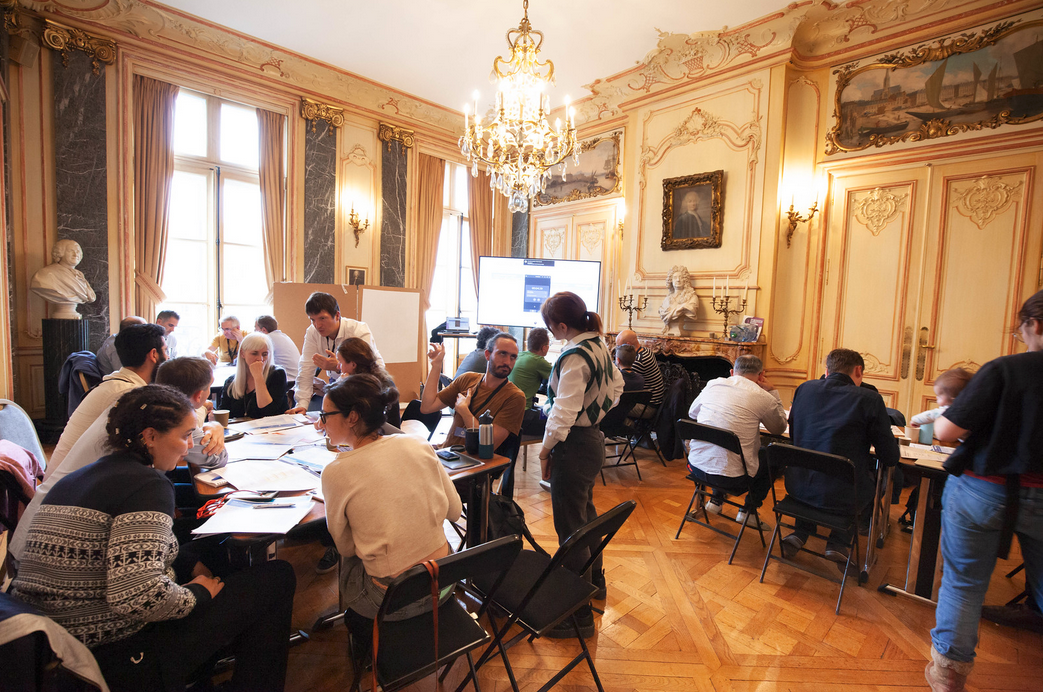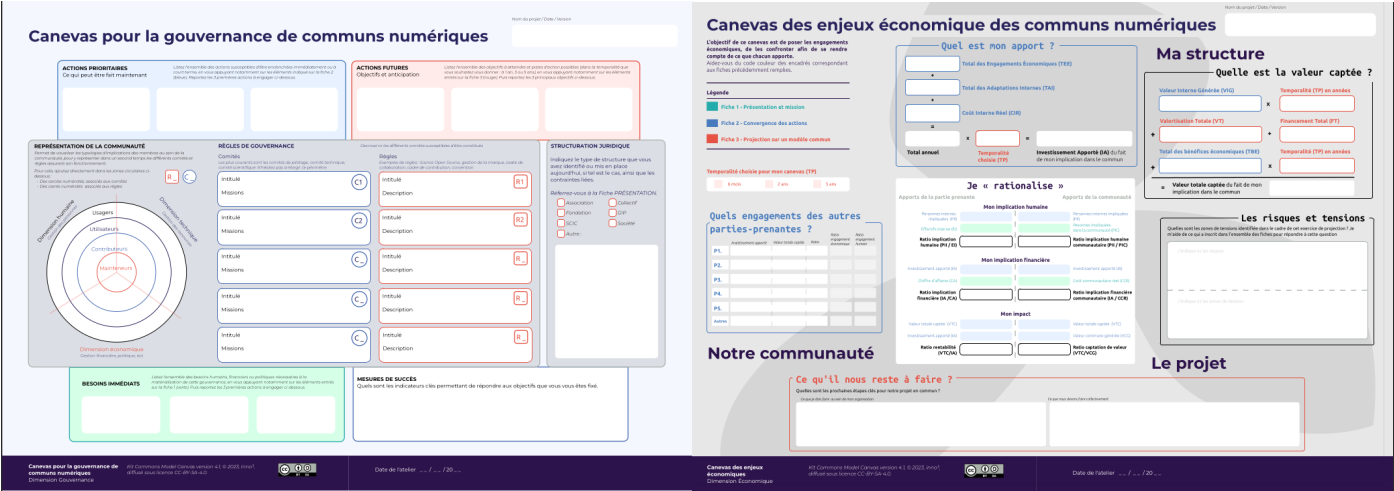Since the first edition of Numérique en Commun[s] (NEC) in 2018, the Digital Society Program - and in particular the Digital Society Laboratory - and inno³ have been collaborating to produce resources and tools dedicated to the appropriation of the commons in an open and collaborative approach :
- The " Tutorial to the Digital Commons ", initiated at NEC 2018 and completed for NEC 2019;
- The " Le Commun numérique et sa ressource " tool sheet, the result of a collaboration between Praticable, the Société Numérique program, Fréquence École and inno³ carried out during NEC 2020 ;
- The " Panorama of the digital commons ", initiated in support of the NEC 2021 workshops;
- The " Canvas for the Governance of the Digital Commons ", produced as part of NEC 2022;
- and the most recent, a Canvas dedicated to the economic dimension of the commons, detailed below, produced in support of NEC 2023.
The Commons Model Canvas to promote appropriation of the commons
What is the Commons Model Canvas?
The Commons Model Canvas is both a method and a guide for digital commons project leaders, to help them think through the specific aspects of the commons: defining governance, dealing with economic issues, organizing the framework for collaboration, and so on.
In the course of our work on the appropriate legal structures for structuring the digital commons, the question of the economic models for these commons regularly came up as the main concern of project leaders. The Commons Model Canvas completes the Canvas for the governance of the digital commons, published in 2022, by materializing the concepts attached to the digital commons dimension. Its aim is to enable the definition of an economic model for the commons, and a related business model for the parties involved in its maintenance and development.
On a collective scale, the business model refers to the strategy put in place to ensure the economic sustainability of the Common from the point of view of both development and maintenance requirements.
The business model refers to each member's ability to generate and capture value, enabling it to make sustainable contributions.
Indeed, the problem of the economic model of the commons, and the business models that can be envisaged for the stakeholders, has been raised among commoners for years. In particular, inno³ has been able to support several projects in defining their business model, either directly at the request of these projects, or on behalf of institutional players wishing to provide support for specific projects (Ademe's Call for Commoners, ANCT's Call for Expressions of Interest "Tooling digital inclusion players", or IGN's Geoplatform project). Many projects have fed into our experience: iTowns, La Rochelle Territoire Zéro Carbone, LaCollecte.tech, Soliguide, XSalto (now Alpilink), etc.
What makes up the Commons Model Canvas?
Available in paper or digital versions, it is a set of self-contained resources that can be assembled to facilitate a variety of situations, from individual reflections to team workshops.
This tool, initiated at NEC 2022 with the Commons Governance Framework, enables digital commons projects to better understand and articulate the complexity of the economic stakes of commons projects in relation to their business models and the stakeholders involved.
To facilitate the workshops, we have produced a "kit" consisting of :
- A user's guide containing a range of resources, tips and examples. A number of resources for further exploration of the issues raised, to make it easier to put them into action.
- A series of 3 cards to help you grasp and materialize all the issues (economic and governance, indicated by pictograms) underlying the digital commons. These cards are double-sided, to mirror the issues raised by each stakeholder (front) and those of the community (back).
- Sheet 1 - "Presentation and Mission" (green): provides an overview of each stakeholder.
- Sheet 2 - "Convergence of actions" (blue): describes the contribution of each stakeholder, the resources they mobilize, and the rules of governance established within the community.
- Sheet 3 - "Projecting onto a common model" (red): allows you to take a step back and project towards predetermined timeframes (6 months, 2 years or 5 years) by articulating scenarios on a multi-dimensional action plan.
- A set of two canvases that can be completed independently of each other and according to the needs of the workshop:
- A " framework for the governance of digital commons" to summarize the rules of governance, the structure and representation of the project community, articulated by actions and indicators.
- A " canvas of the economic stakes of digital commons" to synthesize the business models of each stakeholder in a digital commons, in order to map out what each puts in and what each receives.
The Commons Model Canvas may be supplemented in the future, depending on the needs of project developers.
This kit drew on all inno³'s expertise (legal, design), a bibliography of grey literature and the organization of focus group discussions. Our approach also drew on a more global design approach at inno³ through game design.
You can access all the following resources:
- The "Governance of the digital commons" canvas and the "Economic challenges of the digital commons" canvas make up the Commons Model Canvas,
- Cards to help you complete the canvas,
- Documentation in booklet form to help you run the workshop,
- An outline and ODP format sheets to facilitate completion in an online workshop,
- Source files for all content in SVG format.
The Commons Model Canvas in practice
How to run a workshop using the Commons Model Canvas?
This kit is initially designed to be used in a face-to-face workshop format, with a plurality of profiles gravitating around an identified digital commons project, and a printed version of the booklet. However, we are making available documentation enabling it to be carried out remotely in ODP format.
When running a workshop, we recommend using the following outline:
- Stage 1 - Immersion: This stage introduces the various digital commons projects and forms the groups.
- Step 2 - Exploration: This step enables you to fill in all the double-sided sheets included in the kit.
- Each card has a specific color for easy recognition.
- They contain questions with annotation fields to be completed as the discussion progresses (it is advisable to complete the cards in order).
- The cards can be completed individually or collectively, depending on the needs of everyone around the table during the workshop. The community section of the cards can be completed by all project stakeholders.
- Stage 3 - Convergence: The summary of actions and the elements completed on the cards will be entered on the two templates provided. The answers entered on the forms will feed the canvas. It is therefore advisable to fill in the forms before completing the canvas.
- The governance framework focuses on the governance elements of a digital commons project.
- The business model canvas enables you to map out your business model, in a way that complements those of other community stakeholders, in order to build an economic model that is sustainable for the community and viable for stakeholders.
The recommended workshop time will depend on a number of factors, such as the number of participants, the objectives set and the context. In any case, you should generally allow between 2 and 3 hours to complete all the materials (worksheets and canvas).
Mobilizing the Commons Model Canvas at NEC 2023
For this latest edition of Numérique en Commun[s], inno³ led a workshop entitled "Take charge of (and challenge) inno³'s digital commons support kit". The aim was to introduce and enable participants to take charge of the Commons Model Canvas, a tool designed to help digital commons holders understand and manipulate the necessary concepts, and to project themselves onto a sustainable common economic model.

The large number of participants in this workshop shows the importance of the need for common carriers, whether private or public, to have specific tools to support them in structuring and developing their project.
The participants were divided into four groups, each devoted to an existing commons developed by one of the members. This common was used as a case study to ensure that the framework would be easily understood and used by the players for whom it was intended.
The workshop showed that the Commons Model Canvas addresses most of the issues raised by the participants, in a format that is particularly well-suited to the task, making it easy to learn and complete collectively. However, a number of irritants were raised: information to be requested; vocabulary to be adapted; design to be reworked from time to time; and so on.
This feedback is invaluable, because the Commons Model Canvas, like all the resources resulting from the collaboration between the Digital Society Laboratory and inno³, is intended to be the fruit of collective work. This is why you can now download the Canvas in its version shared with NEC, under a CC-By-SA 4.0 license, so that you can make use of it and make any modifications you wish.
What happens next?
How to contribute to the kit ?
The "Common Model Canvas" Kit is shared under a free CC-by-SA 4.0 license. This means you can adapt it to the specific features of your project, making it the most relevant tool possible.
If you'd like to be involved in future developments, or simply to be kept informed, please contact us at commonsmodelcanvas@inno3.fr.
Don't hesitate to let us know about your experiments and re-appropriations at the same address.
You can also access and contribute to all our content via our Gitlab. If you complete one of the two frameworks and/or the associated sheets, don't hesitate to share this content with us via the Gitlab so that it can be added to the "Examples" folder.





